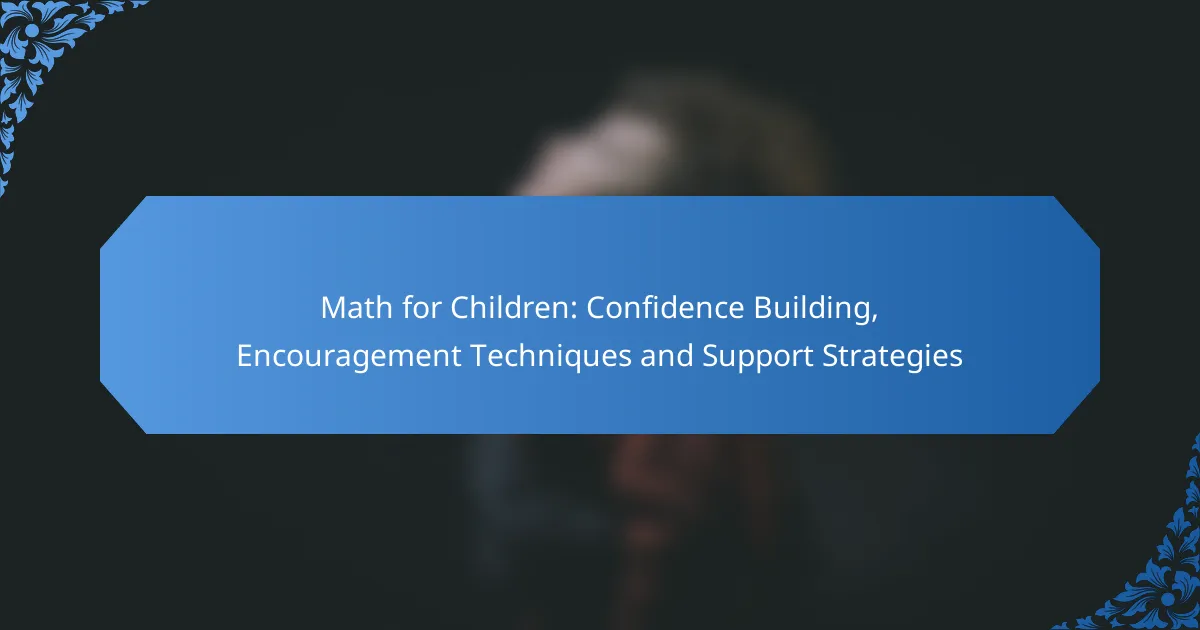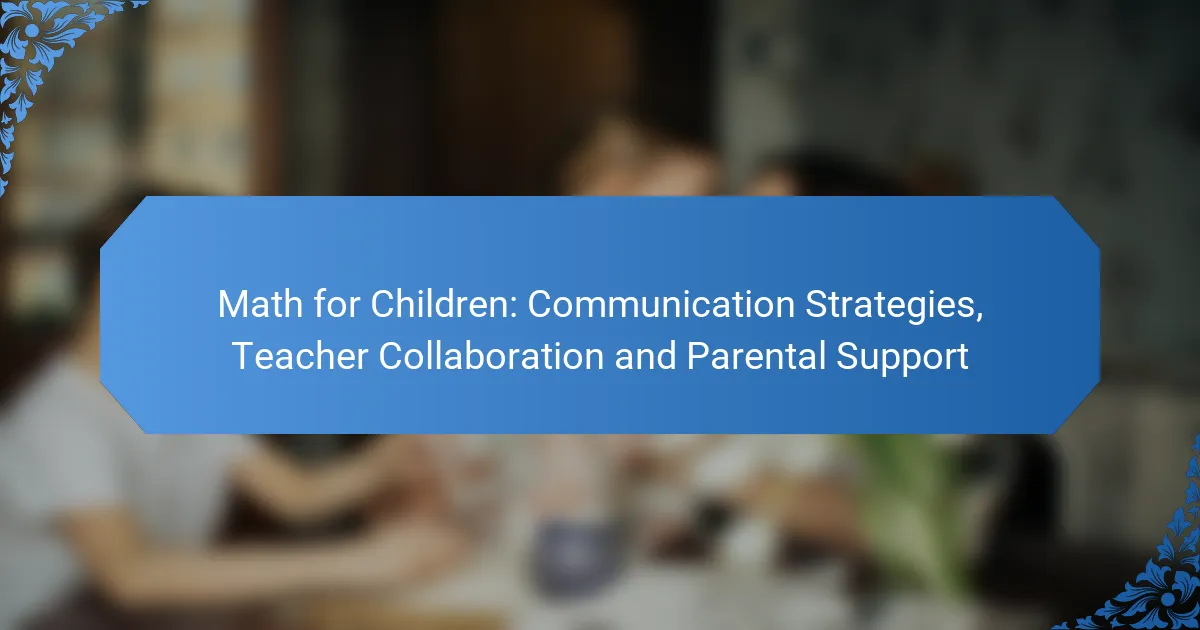Building math confidence in children is essential for fostering a positive attitude toward learning. By implementing effective encouragement techniques and support strategies, caregivers and educators can create an environment that promotes exploration and resilience in mathematics. Personalized tutoring, active parental involvement, and collaborative peer interactions are key components in helping children thrive in their mathematical journey.
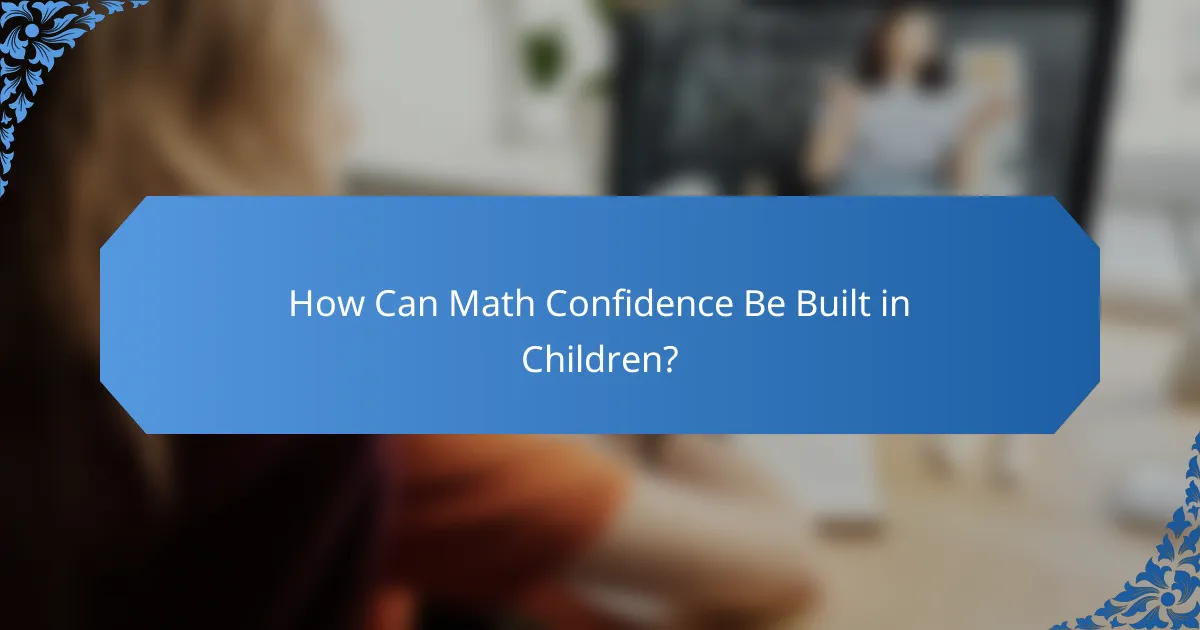
How Can Math Confidence Be Built in Children?
Building math confidence in children involves creating a supportive environment that encourages exploration and learning. By using effective strategies, caregivers and educators can help children develop a positive attitude toward math.
Positive reinforcement techniques
Positive reinforcement is a powerful way to boost a child’s confidence in math. Praising effort rather than just correct answers helps children understand that mistakes are part of the learning process. For example, saying “I love how you tried different methods to solve that problem” reinforces their persistence.
Consider using small rewards, such as stickers or extra playtime, to celebrate achievements. This can motivate children to engage more deeply with math tasks and build their self-esteem over time.
Use of engaging math games
Engaging math games can make learning fun and interactive, which is essential for building confidence. Games that involve problem-solving or strategy encourage children to think critically while enjoying the process. For instance, board games that require counting or basic arithmetic can be both entertaining and educational.
Online math games and apps can also provide instant feedback, allowing children to learn at their own pace. Look for games that adapt to the child’s skill level to keep them challenged without feeling overwhelmed.
Setting achievable goals
Setting achievable goals is crucial for fostering math confidence. Break down larger tasks into smaller, manageable steps, allowing children to experience success along the way. For example, instead of tackling a whole chapter, focus on mastering one concept at a time.
Encourage children to set personal goals, such as completing a certain number of math problems each week. This helps them take ownership of their learning and builds a sense of accomplishment as they meet their targets.
Incorporating real-life applications
Incorporating real-life applications of math can significantly enhance a child’s understanding and confidence. Show them how math is used in everyday situations, such as cooking, shopping, or budgeting. For example, ask them to help measure ingredients while cooking to practice fractions.
Discussing math in the context of their interests, like sports statistics or video game scores, can also make the subject more relatable. This approach not only reinforces their skills but also demonstrates the relevance of math in their daily lives.

What Encouragement Techniques Are Effective?
Effective encouragement techniques help children build confidence in math by fostering a positive attitude and resilience. These methods focus on verbal praise, supportive environments, and collaboration among peers.
Verbal praise and recognition
Verbal praise and recognition are powerful tools for boosting a child’s confidence in math. Acknowledging their efforts, even for small achievements, reinforces their belief in their abilities. For instance, saying “Great job on solving that problem!” can motivate them to tackle more challenging tasks.
It’s essential to be specific with praise. Instead of general compliments, highlight what they did well, such as “I love how you used different strategies to find the answer.” This approach helps children understand their strengths and encourages them to apply those skills in future challenges.
Creating a supportive learning environment
A supportive learning environment is crucial for children to feel safe and motivated to learn math. This includes providing resources such as manipulatives, visual aids, and a quiet space for concentration. Ensuring that children have access to these tools can significantly enhance their learning experience.
Additionally, fostering a culture of patience and understanding among peers can help reduce anxiety around math. Encourage children to ask questions and express their thoughts without fear of judgment. This openness can lead to greater engagement and willingness to learn.
Encouraging peer collaboration
Encouraging peer collaboration can enhance children’s math skills and confidence. Group activities, such as solving problems together or explaining concepts to one another, allow students to learn from their peers. This collaborative approach not only reinforces their understanding but also builds social skills.
To implement this, consider organizing small study groups or math clubs where children can work together on projects. Set clear goals for these sessions, such as completing a specific task or helping each other with challenging problems. This structure promotes teamwork and shared learning experiences.

What Support Strategies Help Children in Math?
Effective support strategies for children in math include personalized tutoring, online resources, and active parental involvement. These approaches can significantly enhance a child’s understanding and confidence in mathematics.
Personalized tutoring options
Personalized tutoring provides tailored instruction that meets a child’s unique learning needs. This can involve one-on-one sessions with a tutor who focuses on specific areas where the child struggles, such as fractions or problem-solving techniques.
When considering tutoring, look for options that offer flexibility in scheduling and a curriculum aligned with school standards. Many tutors also provide progress reports, which can help track improvements over time.
Utilizing online math resources
Online math resources offer interactive and engaging ways for children to practice their skills. Websites and apps often feature games, quizzes, and instructional videos that can make learning fun and accessible.
Popular platforms include Khan Academy and IXL, which provide exercises tailored to various grade levels. Parents should encourage children to explore these resources regularly, aiming for short daily sessions to reinforce learning without overwhelming them.
Parental involvement in learning
Active parental involvement can significantly boost a child’s confidence and performance in math. This can include helping with homework, discussing math concepts during everyday activities, or simply encouraging a positive attitude towards challenges.
Parents should aim to create a supportive environment by celebrating small achievements and providing constructive feedback. Setting aside dedicated time for math-related activities can also help children feel more comfortable and engaged with the subject.

How Can Online Courses Enhance Math Learning?
Online courses can significantly enhance math learning by providing interactive and engaging environments tailored to individual needs. These courses often incorporate various teaching methods that cater to different learning styles, making math more accessible and enjoyable for children.
Interactive course formats
Interactive course formats, such as gamified lessons and live problem-solving sessions, keep children engaged and motivated. These formats encourage active participation, allowing students to practice math concepts in real-time and receive immediate feedback.
For example, platforms may include quizzes, puzzles, and collaborative projects that foster teamwork and critical thinking. This hands-on approach helps reinforce learning and builds confidence in math skills.
Access to expert instructors
Online courses often provide access to expert instructors who specialize in teaching math to children. These educators can offer personalized guidance, answer questions, and provide support tailored to each student’s learning pace.
Having an expert available can help clarify complex concepts and inspire students to explore math further. Many platforms allow for one-on-one sessions, which can be particularly beneficial for children who may struggle with certain topics.
Flexible learning schedules
Flexible learning schedules are a key advantage of online courses, allowing students to learn at their own pace and on their own time. This flexibility can reduce stress and enable children to balance their math studies with other activities.
Parents can encourage their children to set specific times for math practice, making it a regular part of their routine. This approach not only promotes discipline but also helps children develop a positive attitude towards learning math.
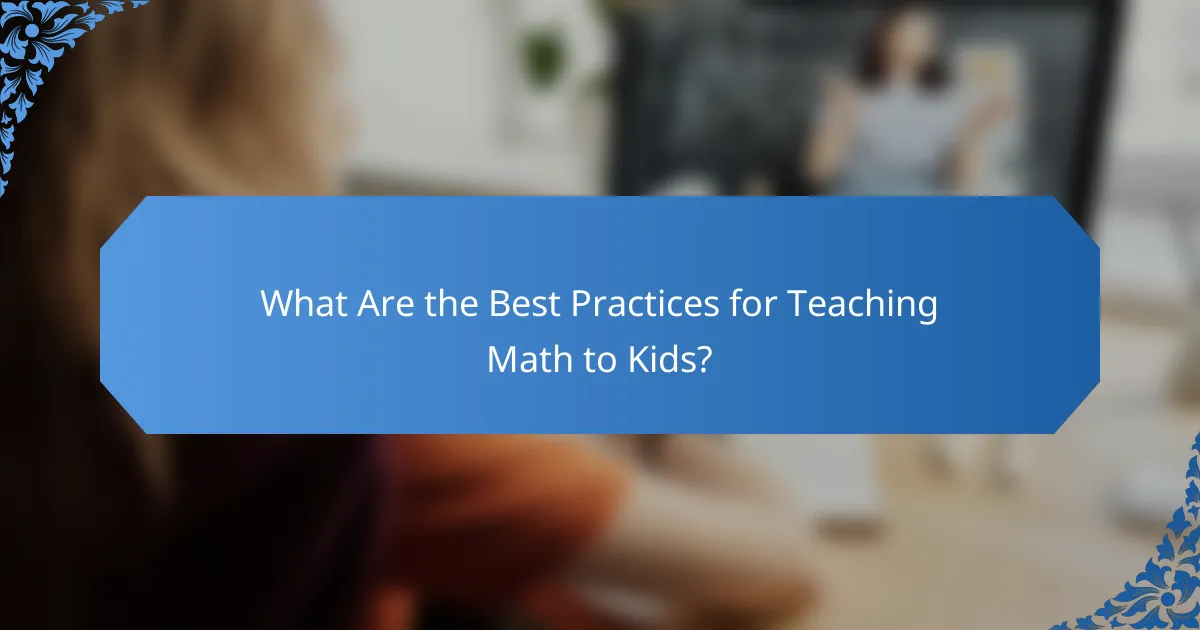
What Are the Best Practices for Teaching Math to Kids?
The best practices for teaching math to kids focus on engaging their interest and building their confidence. Utilizing interactive methods, incorporating technology, and providing consistent feedback are essential strategies that can enhance their learning experience.
Hands-on learning activities
Hands-on learning activities are effective for teaching math concepts as they allow children to explore and discover through play. Activities such as using blocks for counting, measuring ingredients for cooking, or playing math-related games can make abstract concepts more tangible.
Consider incorporating everyday items like coins or measuring cups to create real-world math problems. This approach not only reinforces skills but also shows children how math applies to their daily lives.
Incorporating technology tools
Technology tools can significantly enhance math learning by providing interactive and engaging platforms. Educational apps and online games often tailor lessons to a child’s skill level, making learning more personalized and enjoyable.
Using tools like tablets or computers, children can access a variety of resources, from instructional videos to math puzzles. Ensure that the technology used is age-appropriate and aligns with educational standards to maximize its effectiveness.
Regular assessment and feedback
Regular assessment and feedback are crucial for tracking a child’s progress in math. Simple quizzes, informal observations, and discussions can help identify areas where a child excels or may need additional support.
Provide constructive feedback that highlights strengths while addressing weaknesses. Encourage a growth mindset by praising effort and improvement rather than just correct answers, fostering resilience and a love for learning math.
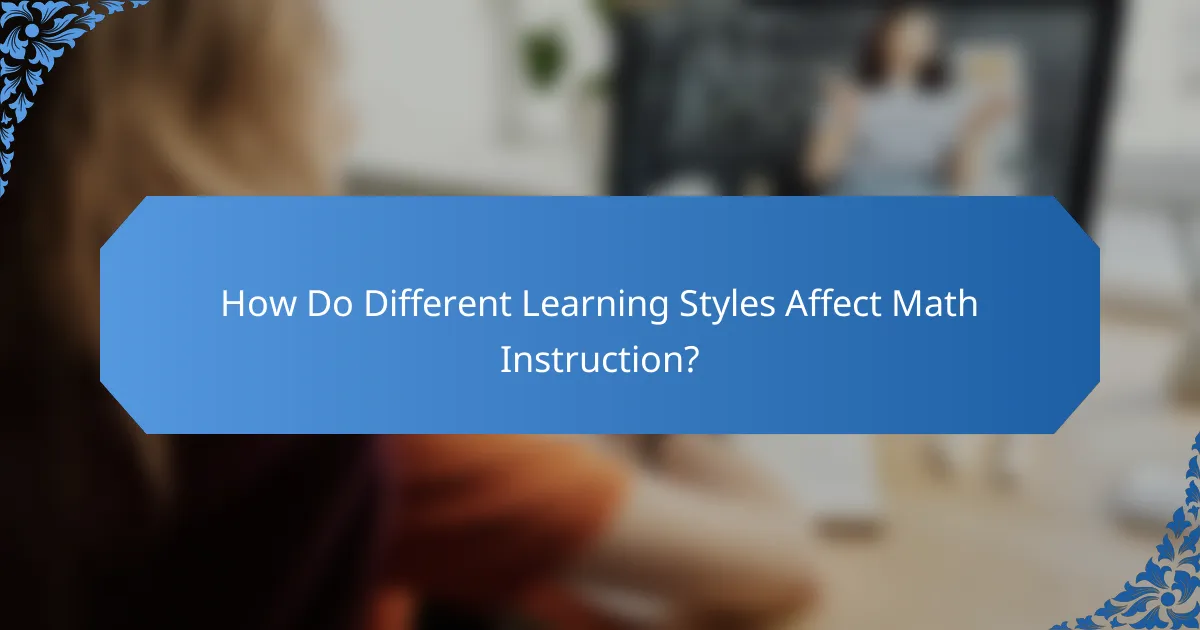
How Do Different Learning Styles Affect Math Instruction?
Different learning styles significantly influence how math instruction is delivered and received. Understanding these styles helps educators tailor their approaches to meet the diverse needs of students, enhancing engagement and comprehension.
Visual Learners
Visual learners grasp mathematical concepts better through diagrams, charts, and visual aids. Incorporating tools like graphs or color-coded notes can help these students visualize relationships and patterns in math.
For example, using pie charts to explain fractions or bar graphs for data comparison can make abstract concepts more tangible. Teachers should encourage visual learners to create mind maps or drawings to represent problems visually.
Auditory Learners
Auditory learners benefit from listening and verbal explanations. They often excel when math concepts are discussed in group settings or through storytelling methods. Incorporating discussions, lectures, or even math songs can enhance their understanding.
For instance, explaining a math problem through a narrative or having students explain their thought processes aloud can reinforce learning. Teachers should encourage these learners to verbalize their reasoning or work in pairs to discuss solutions.
Kinesthetic Learners
Kinesthetic learners thrive on hands-on activities and movement. They often need to manipulate objects or engage in physical activities to understand mathematical concepts. Using tools like blocks, counters, or interactive games can be particularly effective.
For example, using physical objects to demonstrate addition or subtraction can help these students grasp the concepts more effectively. Teachers should incorporate activities that allow kinesthetic learners to move around, such as math scavenger hunts or role-playing scenarios.
Reading/Writing Learners
Reading/writing learners prefer to engage with text and written materials. They benefit from reading math problems and writing out solutions. Providing worksheets, textbooks, and written explanations can support their learning process.
Encouraging these students to summarize math concepts in their own words or keep a math journal can enhance retention. Teachers should provide ample opportunities for reading and writing tasks related to math to cater to this learning style.
